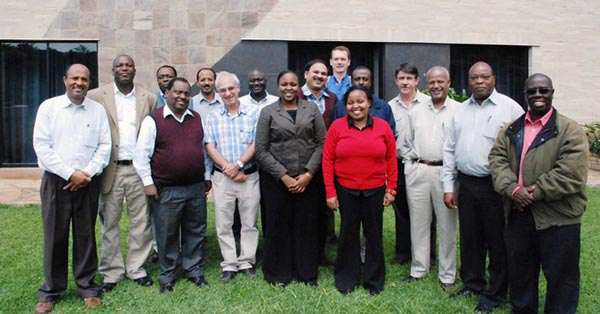MasAgro to offer farmers advice and information through cell phones
 On 1 and 2 August 2012, representatives of public and private organizations interested in developing information technologies for the agricultural sector met at CIMMYT to participate in the MasAgro Movil Think Tank.
On 1 and 2 August 2012, representatives of public and private organizations interested in developing information technologies for the agricultural sector met at CIMMYT to participate in the MasAgro Movil Think Tank.
The objective of the meeting was to present the work that has been done by MasAgro partners to develop and promote Mexican farmers’ adoption of information services provided through mobile phones.
MasAgro Movil is a communications tool being used by “Take It to the Farmer”, MasAgro’s extension strategy, which is still at the pilot stage. According to Philippa Zamora, who is in charge of developing this project at CIMMYT, MasAgro Movil is a platform that can be used to send market recommendations and weather information to farmers using SMS messages.
“By giving farmers easy access to the information produced by MasAgro’s five innovation hubs, cell phones are expected to help increase farmers’ productivity and generate higher returns on the money they invest in production inputs,” said Bram Govaerts, leader of “Take It to the Farmer.”
CIMMYT Director General Thomas Lumpkin pointed out that because researchers involved in MasAgro understand how the different links in Mexico’s agri-food value chain operate, they can work with the private sector on developing business opportunities that will boost the productivity of Mexican farmers.
The business meetings of the MasAgro Movil Think Tank were inaugurated by Francisco Mayorga Castañeda, Mexico’s Secretary of Agriculture, Livestock, Rural Development, Fisheries, and Food. He congratulated CIMMYT for promoting, through MasAgro, public-private partnerships that foster sustainable rural development.
Mayorga Castañeda also emphasized that right from the beginning, MasAgro Movil will have access to 80,000 farmers who will receive advice from 2,000 technicians belonging to the Strategic Program in Support of the Production Chain of Mexico’s Maize and Bean Farmers (PROMAF). For this reason, he is confident the project will be a great success.
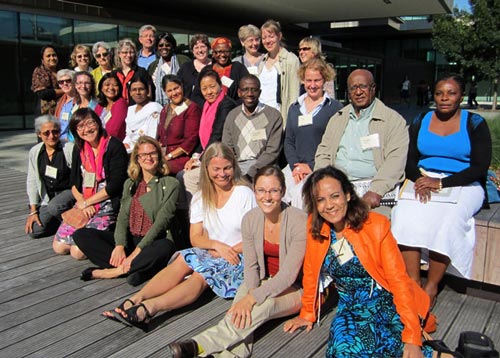 “The workshop was a great opportunity to share ideas and lessons learned, to exchange concepts of different gender strategies, as well as to discuss the latest gender-related research methods,” said Beuchelt. The workshop identified four themes for cross-program research on gender and agriculture: (1) engendering agricultural value chains; (2) gender-transformative approaches; (3) gender and technology adoption and diffusion; and (4) gender and nutrition. The participants also agreed upon a shared set of gender-responsive research outcomes that can be jointly monitored to assess progress towards CGIAR System Level Outcomes. Furthermore, they discussed how to measure these outcomes and agreed to continue collaboration on the development and measurement of a shared set of genderresponsive indicators.
“The workshop was a great opportunity to share ideas and lessons learned, to exchange concepts of different gender strategies, as well as to discuss the latest gender-related research methods,” said Beuchelt. The workshop identified four themes for cross-program research on gender and agriculture: (1) engendering agricultural value chains; (2) gender-transformative approaches; (3) gender and technology adoption and diffusion; and (4) gender and nutrition. The participants also agreed upon a shared set of gender-responsive research outcomes that can be jointly monitored to assess progress towards CGIAR System Level Outcomes. Furthermore, they discussed how to measure these outcomes and agreed to continue collaboration on the development and measurement of a shared set of genderresponsive indicators.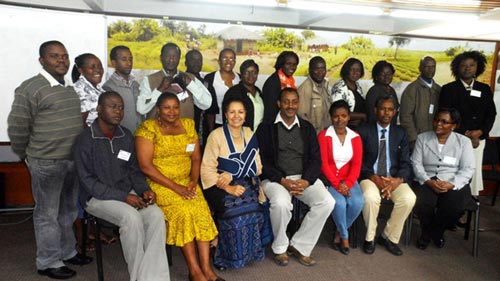
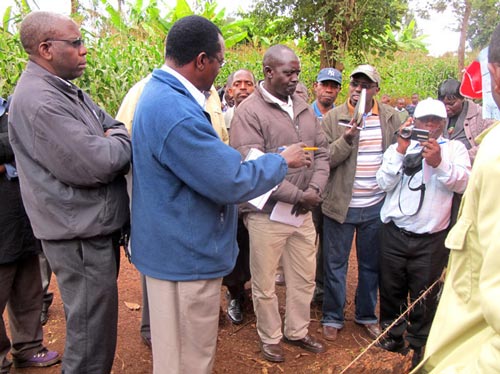 A delegation of scientists from South Sudan, Rwanda, and Uganda —the spillover countries of the Sustainable Intensification of Maize-Legume Systems for Food Security in Eastern and Southern Africa (SIMLESA) initiative— visited Embu, Kenya, during 18-20 July 2012, to gain hands-on experience in implementing the program and to learn about its impact on livelihoods of smallholder farmers.
A delegation of scientists from South Sudan, Rwanda, and Uganda —the spillover countries of the Sustainable Intensification of Maize-Legume Systems for Food Security in Eastern and Southern Africa (SIMLESA) initiative— visited Embu, Kenya, during 18-20 July 2012, to gain hands-on experience in implementing the program and to learn about its impact on livelihoods of smallholder farmers.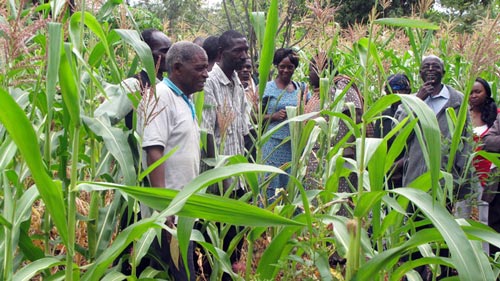
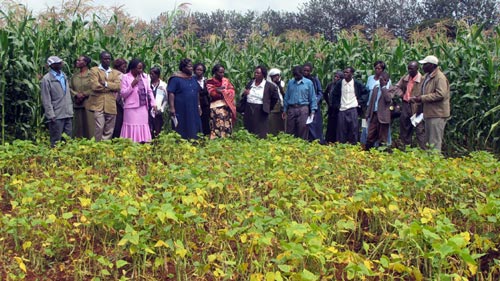
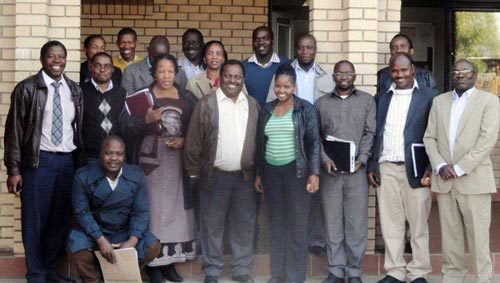
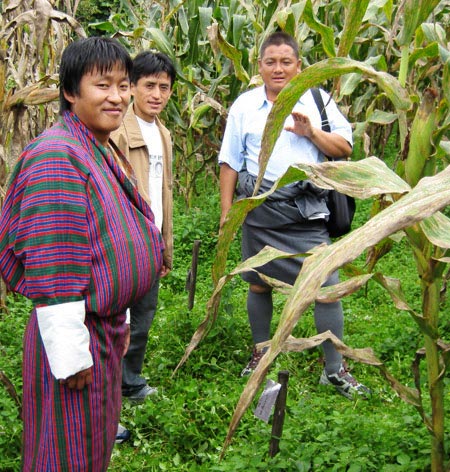 Maize is one of the major staples in Bhutan and is cultivated by about 70 percent of households throughout the country. Poor farmers sustain their families by consuming maize as a staple food, using it as animal feed, and selling it for further income. Thus, the 2007 outbreak of Gray Leaf Spot (GLS), a new disease caused by Cercospora zeae-maydis, posed a major challenge to the Bhutanese maize program and maize farmers, many of whom lost over 70 percent of their production.
Maize is one of the major staples in Bhutan and is cultivated by about 70 percent of households throughout the country. Poor farmers sustain their families by consuming maize as a staple food, using it as animal feed, and selling it for further income. Thus, the 2007 outbreak of Gray Leaf Spot (GLS), a new disease caused by Cercospora zeae-maydis, posed a major challenge to the Bhutanese maize program and maize farmers, many of whom lost over 70 percent of their production.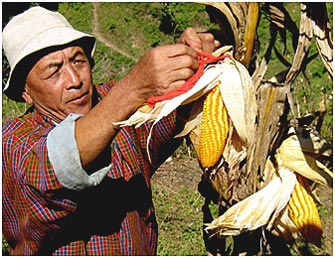 The replacement of seeds has been facilitated through Community Based Seed Producers (CBSP) groups. In 2011 and 2012, over eight tons of seed was supplied to GLS-affected farmers in 10 districts. The average yield recorded under farmers management was 3.73 t/ ha for S03TLYQAB05, and 4.43 t/ ha for ICAV305. Production of basic and foundation seeds has started at research farms and will serve as seed source for the CBSP groups. By 2013, the National Maize Program aims to replace 80 percent of the seeds for GLSaffected farmers cultivating maize above 1,500 masl. The program cooperates with the National Seed Center and CBSP groups to achieve higher efficiency in seed replacement.
The replacement of seeds has been facilitated through Community Based Seed Producers (CBSP) groups. In 2011 and 2012, over eight tons of seed was supplied to GLS-affected farmers in 10 districts. The average yield recorded under farmers management was 3.73 t/ ha for S03TLYQAB05, and 4.43 t/ ha for ICAV305. Production of basic and foundation seeds has started at research farms and will serve as seed source for the CBSP groups. By 2013, the National Maize Program aims to replace 80 percent of the seeds for GLSaffected farmers cultivating maize above 1,500 masl. The program cooperates with the National Seed Center and CBSP groups to achieve higher efficiency in seed replacement.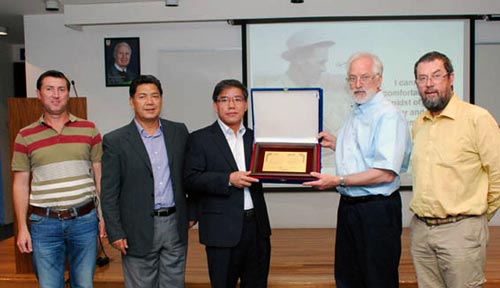 RDA is a central government organization responsible for agricultural research and services. Since its foundation, it has helped South Korea to achieve self-sufficiency in rice and other staple food production through dissemination and promotion of high-yielding cultivars and improved cropping technologies, and contributed to the improvement of the rural environment.
RDA is a central government organization responsible for agricultural research and services. Since its foundation, it has helped South Korea to achieve self-sufficiency in rice and other staple food production through dissemination and promotion of high-yielding cultivars and improved cropping technologies, and contributed to the improvement of the rural environment.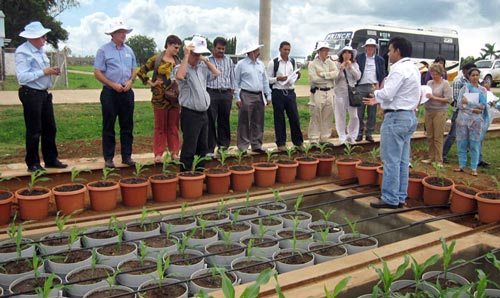 After a formal introduction, Zaidi gave an overview of the research program and priorities of the CIMMYT-Asia maize program, and the ongoing collaborations with various public and private institutions in the region, including the International Maize Improvement Consortium (IMIC-Asia). He emphasized CIMMYT’s initiatives towards purposeful partnerships, which offer a big opportunity for pro-poor agricultural investment and innovations (such as IMIC-Asia and MAIZE), the global alliance for food security, and the livelihood of resource-poor in the developing world.
After a formal introduction, Zaidi gave an overview of the research program and priorities of the CIMMYT-Asia maize program, and the ongoing collaborations with various public and private institutions in the region, including the International Maize Improvement Consortium (IMIC-Asia). He emphasized CIMMYT’s initiatives towards purposeful partnerships, which offer a big opportunity for pro-poor agricultural investment and innovations (such as IMIC-Asia and MAIZE), the global alliance for food security, and the livelihood of resource-poor in the developing world.